Red pepper (Piper nigrum) is one of the special products made from ripe and high-quality pepper fruits. Because of its high quality, red pepper is often sold at much higher price than that of black pepper, which brings farmers high incomes. However, at present, processing technology of red pepper in Vietnam is not completed yet. Red pepper has been mainly produced by using natural drying method. As the result, the quality of products is low, the color of peppercorns is not satisfactory and its taste is not really different compared with other pepper products. The method of heat pump drying being widely used in the processing of agricultural products and foodstuffs to keep color and quality of the products (especially for products are easily destroyed by heat like vitamins). Research on red pepper production by applying the method of heat pump drying had been conducted by WASI from 2017. Result for the determination of the best heat pump drying mode was that: temperature is 350C, air humidity is 40%, wind speed is 3m/s, drying time is 36 h. The red pepper retained natural color of ripe beans. Its taste and other quality criteria were better than that of control samples. Besides, the treatment of raw material was processed by hot water at 900C in 1 min before drying is able to improve quality of red pepper products.
Keywords: Pepper processing, red pepper, heat pump drying, drying mode, Piper nigrum
INTRODUCTION
Nowadays, peppercorn is one of Vietnam’s key export commodities with output of 215,000 tones, and export turnover of $ 1.12 billion [1]. However, the 95% of exported pepper products is black pepper. The export price of black pepper is usually lower than other pepper products from 30% to 40% of value [2]. In Vietnam, red pepper products were only produced in two districts: Chu Se (Gia Lai) and Phu Quoc (Kien Giang). The production volume is not high, but the price of red pepper is 3 - 4 times higher than black pepper. Production technology of red pepper is quite simple, such as manual drying or heat drying. New technologies and equipment are not applied yet, such as enzyme deactivation, freeze drying and high frequency waves technology so that the quality and color of the products are not stable.
The advantage of heat pump drying method is that the drying process can be carried out at low temperature and low humidity, resulting in little impact on biochemical changes of product by heat. In addition, the circulatory drying system is able to keep the smell, taste and nutritional ingredients; limit the loss of taste of the material and help to increase the value of the product after drying. Therefore, the method of drying heat pump is very cared and applied to many products such as dried fruits, vegetables, seafood, and spices. Research on using the heat pump drying method for red pepper is a feasible way in order to increase the value of red pepper, and stabilize the quality and color of products.
MATERIALS AND METHODS
Materials
- Materials: Fresh peppercorns were harvested in Dak Lak province, Viet Nam, then were separated, cleaned and graded before testing.
- Equipment: Heat pump drying system had manufactured
in Viet Nam. The system includes 20 drying racks and a set of controllers of drying temperature, humidity and time. Its capacity is 150 kg per batch.
- Research location: The Western Highlands Agriculture and Forestry Science Institute (WASI)
Methods
Experiment 1: Determination of suitable drying temperature for red pepper
The experiment was used completely randomized design (CRD) with 1 factor and 4 treatments. Each treatment used 30 kg of pepper material and was replicated 3 times. Each treatment was dried at different temperatures, but used the same input air humidity of 40% and wind speed at 3 m/s. The variation in temperature and humidity is less than ± 20C and 3%, respectively. The experiment was organized as follows:
- Treatment 1: Drying at 250C
- Treatment 2: Drying at 300C
- Treatment 3: Drying at 350C
- Treatment 4: Drying at 400C
Experiment 2: Determination of method for processing raw materials before drying in order to improve the product quality
The experiment was used completely randomized design (CRD) with 1 factor and 4 treatments. Each treatment used 30kg of pepper material and was replicated 3 times. Using the best drying temperature from experiment 1. The experiment was organized as follows:
- Treatment 1: Using hot water 900C in 1 min
- Treatment 2: Using high frequency waves 2450Mhz, 2000w in 30s.
- Treatment 3: Using water in 2 min
- Treatment 4: Control (untreated)
Indicators:
- Quality of raw materials: determine the color bean by sensory
- Moisture: was determined by the method of drying to constant weight.
- Color and taste of the product: were evaluated by sensory
- Peperine content (%): was determined according to TCVN 9683: 2013 [3].
- Volatile oils content (ml/100g): was determined according to TCVN 7039-2013 [4].
RESULTS AND DISCUSSION
Determination of suitable drying temperature for red pepper
Fresh peppercorn has been dried at different temperatures, air humidity of 40% and wind speed at 3 m/s. Air humidity in the drying chamber varied according to the dry level of the peppercorn. The quality criteria of raw materials, moisture reduction rate of peppercorn, the quality of products was determined to evaluate effects of heat pump drying method on red pepper.
Results on determining the quality of raw materials
The quality of pepper raw materials directly impacts on the quality of products after drying. Materials used to produce red pepper usually include peppercorn with different color. This has significant influence on the quality of final products. Color changes during drying process would lead to negative effects on the quality of the final products.
The Table 1 shows the quality of raw materials used for producing red pepper. As seen from the table, although raw materials were selected before processing, there were still presence of many peppercorns with different colors. In general, dark red, red and yellow are good colors for processing red pepper. However, some green and black beans will adversely affect to the quality of the final products. The results show that the quality of raw materials for the experiment was quite good with 19.6% dark red beans, 37.8% light red bean and 32.3% yellow beans. Besides, there were a small rate of green beans (7.1%) and black beans (3.2%).

Results on determining changes of moisture content during drying process
According to TCVN 7036-2008, the moisture content for pepper preservation is 12-13% wb. Thus, peppercorn should be dried as required. Changes of the peppercorn moisture could cause changes of pepper colors during drying.
The results (Figure 1) show that the peppercorn moisture reduction between the treatments was different. The drying temperature was higher, the drying speed was faster and the drying time was shorter. For Treatment 1 (drying at 250C), it took 48 h to dry raw material to reach moisture as required (12 - 13%); 40 h for treatment 2 (drying at 300C); 36 h for treatment 3 (drying at 350C); and 32 h for treatment 4 (drying at 400C). it took the longer the drying time was, the more influent the quality of product would be. The higher temperature was, the more effective the product quality would be.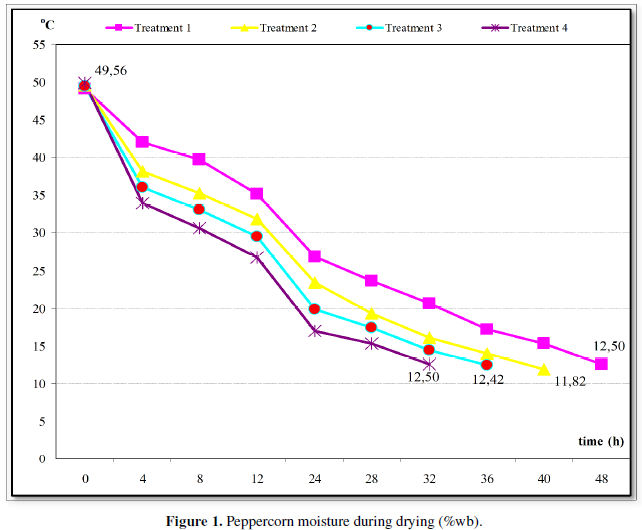
Results on determining the quality of final products
During the drying process, the color of the pepper will be changed according to drying temperatures and drying times (Table 2).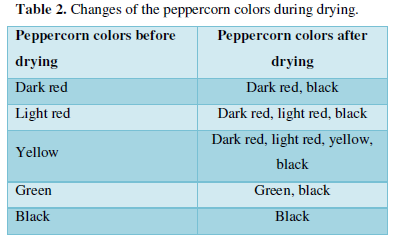
Red pepper in the treatments was dried at different temperatures, the drying time of the products was different. As the result, the products would be different in peppercorn color ratio (Table 3).
From the results, the color of final product in each treatment had significant different comparing to the control (natural drying). For treatments using heat-pump drying, the percentage of gains that were changed in color during drying was lower than that for control sample, especially for red and yellow beans. The percentage of the black beans in treatments (27.2 - 32.2%) was statistically significantly lower than that of the control samples (63.2%). The heat pump drying system proves to be able to keep the light red color of pepper quite well, between 27.3% and 33.2% in which, the lower temperature gave the higher ratio of pepper with light red color. However, the high temperature from 350C to 400C contributed to reduce the ratio of these pepper significantly. Thus, it should be set the drying temperature under 350C in order to gain products with high ratio of red beans and low ratio of black beans. The result of evaluation of pepperine content (4.74 - 4.8%) and volatile oil content (2.18 - 2.26 ml/100g of dry matter) shows that there was not any difference between the drying treatments; and there was not much differences comparing with the control samples. These results correspond to the results of Srinivasan [5-7]. The product after drying has the spicy flavor which is characteristic aroma of pepper.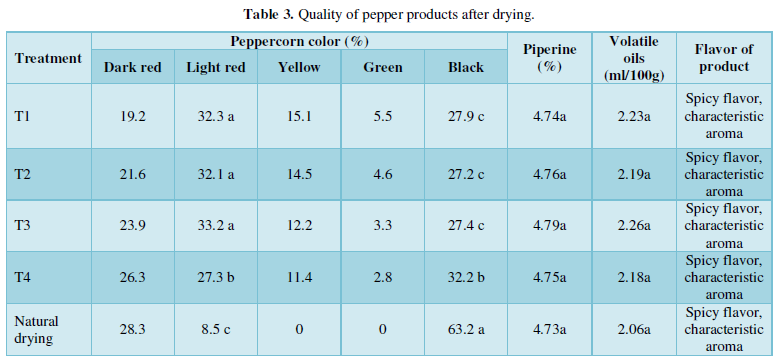
Determination of method for processing raw materials before drying to improve the quality of products
Results of determination of raw material quality
The purpose of processing raw materials before drying is to inactivate the enzyme inside the beans in order to reduce the color change of the pepper happening during drying.
The results (Table 4) show that after processing, there was slightly difference in the color of pepper between these treatments and raw material. Treatment 3, which used, cold water to treat raw material, did not affect the color of pepper. Thus, the color of pepper was the same as the color of raw material. In treatment using hot water, the raw materials after processing have been changed in color from yellow to light red and from light red to dark red. Dark red beans ratio have increased about 5% compared to the raw material (from 18.6% to 20.4%). In treatment processing raw material with microwave, there was a quick change in color, especially from light red to dark red. Dark red beans ratio have increased about 8% compared to the raw material (from 18.6% to 21.5%).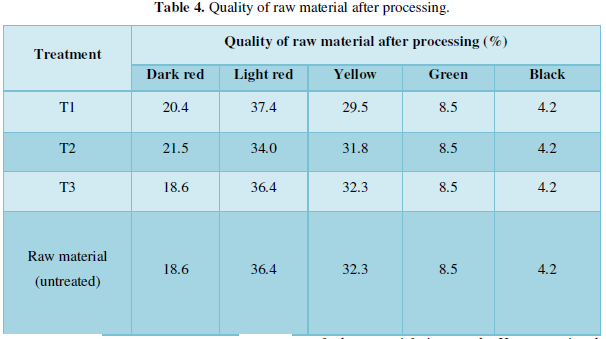
Results of determination peppercorn moisture during drying
The results (Figure 2) show that when the raw materials processed by cold water and hot water, the moisture content of the material increased. However, in the treatment processed by hot water, the moisture of the material reduced quickly after 4 h and had equal amount to the control while in the treatment processed by microwave, the moisture content of the raw materials reduced quickly from the begin of drying step and was always at the lowest level during drying compared to other treatments. In contrast, the moisture content of pepper in the treatment processed with cold water increased quickly from the begin of drying and was always at the highest level compared to other treatments during drying. The treatment processed by microwave gave product with the required moisture (12-13%) after 32 h of drying. It took 36 h for treatments processed by hot water and control to gain desired moisture while the treatment using cold water was not able to achieve required moisture after 36 h of drying.
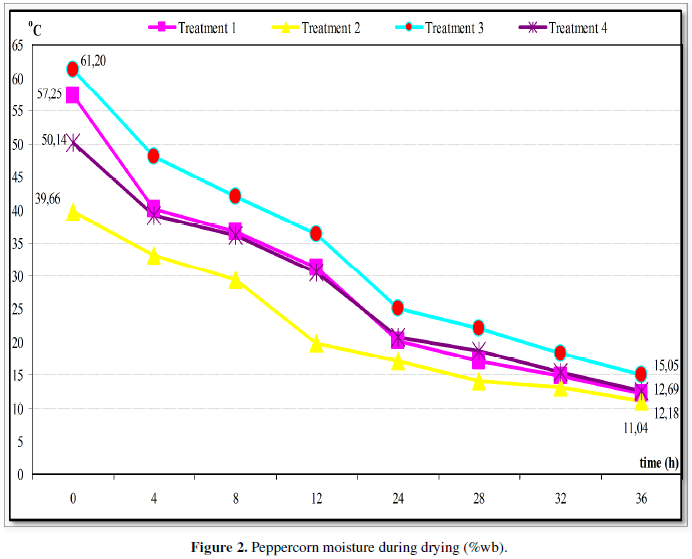
Results of determination quality final product
The results (Table 5) show that the color of the peppercorn beans between the treatments was significant difference. The treatments processed by hot water and microwave made the color of peppercorns very nice (the light red beans were higher) and reduced the ratio of the black beans. It was probably because processing by hot water and microwave was able to inactivate enzyme, which contribute to the maintenance of the color of product better and not making the color of raw materials to be changed too much during drying. The peppercorn color of the treatment processed with cold water were not significantly different compared to the control. In order to use microwave for treating raw material in large quantities, it is necessary to invest in high-value equipment with high safety level for workers. Therefore, it is recommended that hot water should be used in processing raw material before drying in order to decrease investment cost.
The results of the evaluation of pepper content, volatile oil content and product quality show that there was not difference between the treatments. The content of pepperine (4.76 - 4.81%), volatile oil content (2.14 - 2.20 ml/100g dry matter) is correspond to the results of Saha [6] and Morshed [7]. The product of all treatments had a spicy flavor which is the characteristic aroma of pepper. The treatment processed by hot water produced cleaner product compared to other treatments.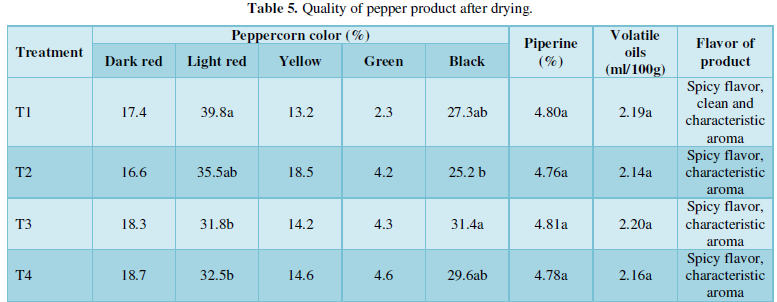
CONCLUSION AND RECOMMENDATION
- The heat pump drying mode suitable for red pepper production was: drying temperature at 350C, air humidity 40%, wind speed of 3m/s and drying time in 36 h. the moisture content of products was less than 13%, black pepper ratio was 27.5%, color and sensory quality of products were very good
- The treatment of raw materials with hot water at 900C in 1 min was able to increase product quality and keep the color of product better and shorten drying time (Figure 3).













